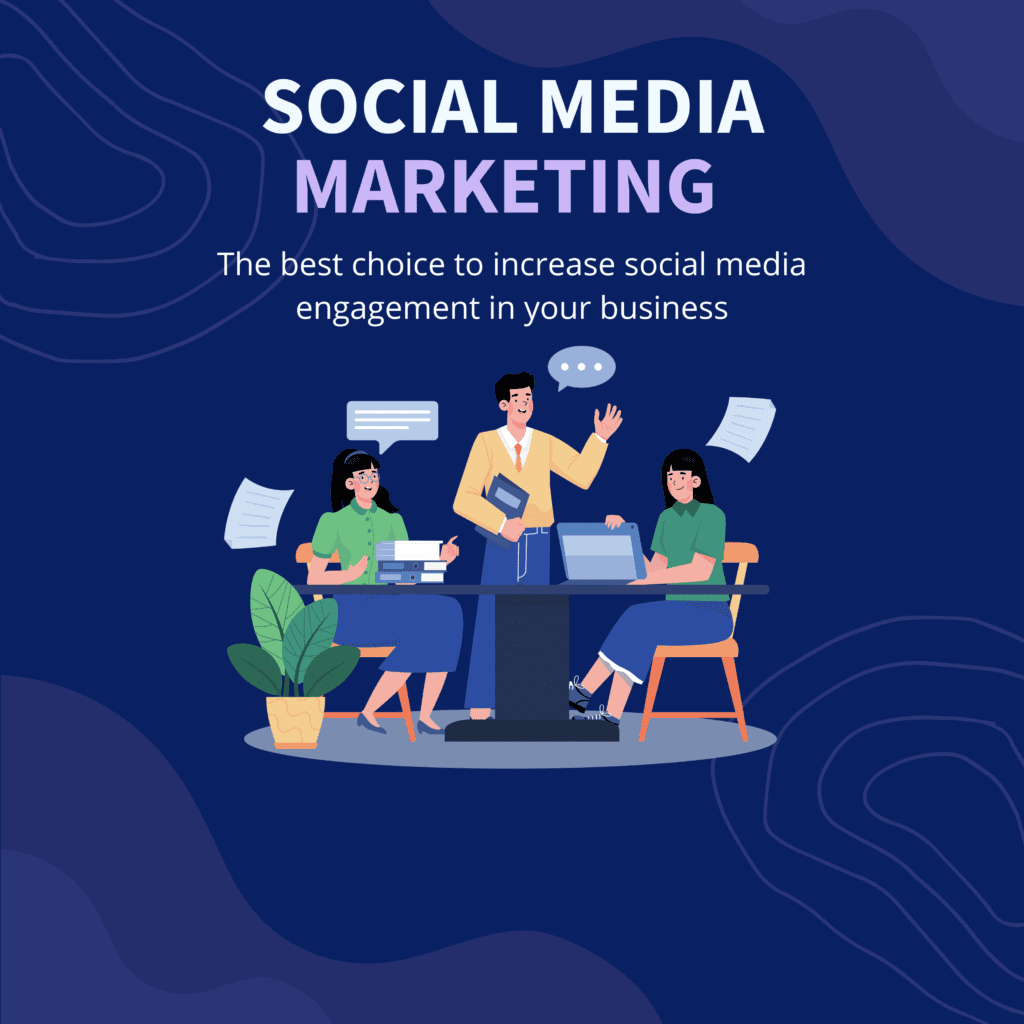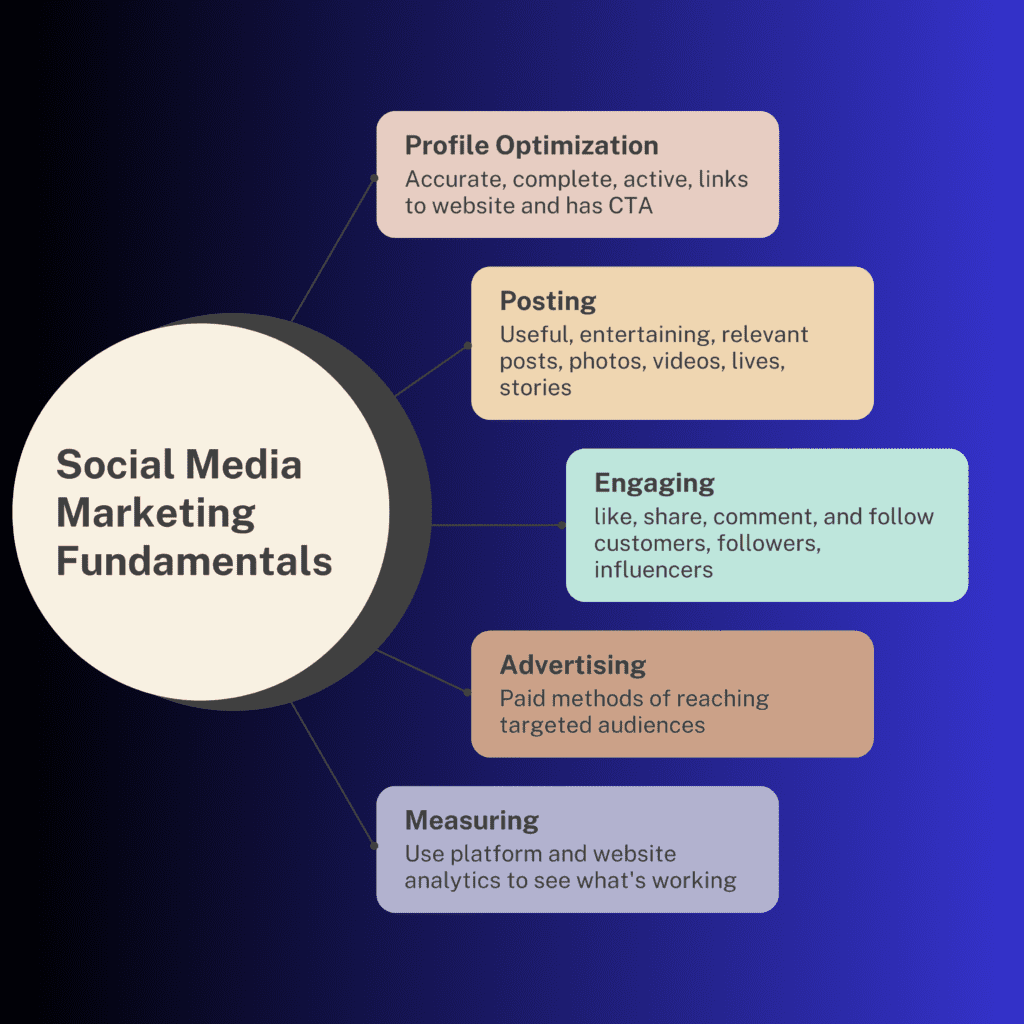Social Media Marketing: The Ultimate Guide to Growing Your Brand

What is Social Media Marketing?
Social Media Marketing (SMM) is a digital marketing strategy that involves using social media platforms to promote a brand, engage with customers, and drive traffic to a website. Businesses leverage platforms like Facebook, Instagram, Twitter, LinkedIn, YouTube, and TikTok to reach their target audience, build brand awareness, and increase sales.
With billions of active users, social media is one of the most cost-effective and powerful tools for businesses to connect with their audience in real-time.
Why is Social Media Marketing Important?
Social Media Marketing (SMM) plays a crucial role in modern digital marketing strategies. With billions of active users on platforms like Facebook, Instagram, Twitter, LinkedIn, YouTube, and TikTok, businesses have a massive opportunity to reach their target audience, build brand awareness, and drive sales. Here’s why social media marketing is essential for businesses today:
1. Increases Brand Awareness
Social media helps brands connect with a global audience by making their content easily shareable. Consistently posting engaging content ensures that your brand stays visible and memorable to potential customers.
2. Drives Website Traffic
Social media posts, stories, and ads can direct users to your website, increasing traffic and conversions. Well-placed Call-to-Actions (CTAs) encourage users to explore your products or services.
3. Cost-Effective Marketing Strategy
Compared to traditional marketing, social media marketing is affordable. Organic posts are free, while paid ads allow businesses to target specific audiences at a lower cost than print or TV advertising.
4. Improves Customer Engagement
Social media creates a two-way communication channel where businesses can interact with customers in real-time through comments, likes, shares, and messages. Engaging with followers builds trust and strengthens customer relationships.
5. Helps Businesses Stay Competitive
In today’s digital age, businesses that don’t leverage social media risk falling behind competitors who actively engage with their audience online. A strong social media presence establishes credibility and enhances brand reputation.
6. Boosts Lead Generation and Sales
Platforms like Facebook and Instagram offer targeted advertising that helps businesses reach the right audience. Social media ads, influencer collaborations, and retargeting campaigns are powerful tools for increasing sales and generating leads.
7. Provides Valuable Customer Insights
Social media platforms provide analytics and data that help businesses understand customer behavior, preferences, and engagement patterns. This data allows brands to optimize marketing strategies for better results.
8. Enhances SEO Performance
Active social media engagement contributes to search engine rankings. While social signals (likes, shares, and comments) don’t directly impact SEO, they increase content visibility, leading to higher website traffic and backlinks.
9. Builds Brand Loyalty and Trust
Engaging with customers, responding to queries, and sharing valuable content builds a loyal community. Brands that interact with their audience regularly earn customer trust and long-term loyalty.
10. Keeps Your Business Relevant
Social media trends evolve quickly. Businesses that stay active and adapt to new trends, challenges, and viral content remain relevant and capture audience attention.

How Does Social Media Marketing Work?
Social Media Marketing (SMM) works by leveraging social media platforms to promote products, services, and brands, ultimately driving engagement, website traffic, and sales. It involves creating, sharing, and analyzing content to connect with the right audience. Here’s a step-by-step breakdown of how social media marketing works:
1. Define Your Goals
The first step is to establish clear objectives for your social media marketing efforts. Your goals might include:
- Increasing brand awareness
- Driving website traffic
- Generating leads and sales
- Boosting customer engagement
- Building a loyal customer base
2. Identify Your Target Audience
Understanding your audience is crucial for creating relevant content. Consider:
- Demographics (age, gender, location, interests)
- Pain points (problems your audience faces)
- Preferred social media platforms (Instagram, Facebook, LinkedIn, Twitter, etc.)
Using analytics tools, you can track who engages with your content and refine your marketing strategy accordingly.
3. Choose the Right Social Media Platforms
Each platform has unique benefits, and choosing the right ones depends on your audience and industry.
- Facebook – Best for brand awareness, community building, and paid advertising.
- Instagram – Ideal for visual content (images, reels, and stories) and influencer marketing.
- LinkedIn – Best for B2B marketing, networking, and industry-related content.
- Twitter (X) – Great for real-time updates, brand conversations, and customer service.
- YouTube – Perfect for long-form video content like tutorials, product demos, and vlogs.
- TikTok – Best for viral marketing, engaging short videos, and younger audiences.
4. Create High-Quality Content
Content is the heart of social media marketing. Your content should be:
Engaging & Valuable – Provide helpful information or entertainment.
Visually Appealing – Use high-quality images, videos, and infographics.
Consistent & On-Brand – Maintain a recognizable style and tone.
Types of Content for Social Media Marketing:
- Blog posts & articles
- Images & infographics
- Videos & reels
- Polls & interactive posts
- Stories & behind-the-scenes contentLive streaming sessions
5. Engage with Your Audience
Social media is about building relationships. Actively engage by:
- Responding to comments, messages, and mentions
- Hosting Q&A sessions and live events
- Encouraging user-generated content (UGC)
- Running contests and giveaways
Engagement boosts brand trust and loyalty, making customers more likely to choose your brand.
6. Leverage Paid Advertising & Influencer Marketing
- Paid Ads: Platforms like Facebook Ads and Instagram Ads allow businesses to target specific audiences with sponsored posts.
- Influencer Marketing: Collaborating with influencers helps brands gain credibility and expand their reach.
Both strategies enhance brand visibility and improve conversion rates.
7. Analyze & Optimize Performance
Measuring your performance is key to improving your social media strategy. Use analytics tools like:
- Facebook Insights
- Instagram Analytics
- Twitter Analytics
- Google Analytics
Key performance metrics to track:
Engagement rate (likes, shares, comments)
Follower growth
Website clicks
Lead generation & conversions
By analyzing data, you can refine your approach to achieve better results.

Types of Social Media Marketing
Social Media Marketing (SMM) consists of various strategies used to promote businesses, engage audiences, and increase brand awareness. Below are the main types of social media marketing:
1. Organic Social Media Marketing
This involves free strategies to grow an audience and build brand trust without paid promotions.
- Posting valuable content – Images, blogs, infographics, and videos
- Engaging with followers – Replying to comments, messages, and mentions
- Using hashtags – To increase content visibility
- Creating communities – Facebook groups, LinkedIn groups, etc.
Best for: Small businesses, startups, and brands looking to build long-term customer relationships.
2. Paid Social Media Marketing
Paid promotions help businesses reach a wider and targeted audience quickly
- Sponsored Ads – Facebook, Instagram, and LinkedIn Ads
- Boosted Posts – Paying to increase reach on high-performing content
- Retargeting Ads – Targeting users who have previously interacted with your brand
- Pay-Per-Click (PPC) Campaigns – Paying for each click on your ad
.
Best for: Businesses looking for immediate brand exposure and lead generation.
3. Influencer Marketing
Collaborating with social media influencers to promote products/services to their followers.
- Micro-Influencers (10K–100K followers) – Ideal for niche markets
- Macro-Influencers (100K–1M followers) – Great for broad audiences
- Celebrity Influencers (1M+ followers) – High-impact but expensive
Best for: Brands wanting to gain trust and credibility through third-party endorsements.
4. Video Marketing
Videos are one of the most engaging forms of content on social media.
- Live Videos – Webinars, Q&A sessions, product launches
- Short-Form Videos – Instagram Reels, TikTok, YouTube Shorts
- Long-Form Videos – Tutorials, vlogs, behind-the-scenes content
Best for: Brands looking to increase engagement, educate their audience, and boost conversions.
5. Social Media Contests & Giveaways
Running contests and giveaways to increase engagement and brand visibility.
- Like, Comment & Share Contests – Encourages interactions
- Hashtag Challenges – Increases brand awareness
- Referral Contests – Reward users for inviting friends
Best for: Brands looking to boost engagement and grow followers quickly.
6. Social Media Listening & Customer Service
Monitoring social media conversations to understand audience sentiment and improve customer support.
- Responding to customer queries quickly
- Tracking brand mentions using tools like Hootsuite & Sprout Social
- Handling negative feedback professionally
Best for: Businesses wanting to enhance their reputation and build customer trust.
7. User-Generated Content (UGC) Marketing
Encouraging customers to create and share content about your brand.
- Customer Reviews & Testimonials – Builds trust
- Tagging Customers in Posts – Encourages sharing
- Reposting User Content – Strengthens brand loyalty
Best for: Brands aiming for authentic marketing and community-building.
8. Social Media Affiliate Marketing
Partnering with affiliates who promote your products and earn a commission on sales.
- Affiliate Links – Unique tracking links for affiliates
- Discount Codes – Special promo codes to track affiliate performance
- Influencer Affiliates – Content creators promoting products through affiliate programs
Best for: E-commerce businesses looking to increase sales through third-party promotions.
9. Social Commerce (Selling on Social Media)
Using social media platforms to sell products directly without directing customers to a website.
- Facebook & Instagram Shops – Set up a digital storefront
- Pinterest Buyable Pins – Users can purchase directly from pins
- TikTok & YouTube Shopping – Influencers promote shoppable links
Best for: E-commerce businesses and brands aiming to boost direct sales on social media.
How to Create a Social Media Marketing Strategy?
A strong social media marketing strategy helps businesses attract, engage, and convert their audience into customers. Below are the step-by-step instructions to create a successful social media strategy.
1. Define Your Goals & Objectives
Before starting, determine what you want to achieve with social media marketing. Your goals should be SMART (Specific, Measurable, Achievable, Relevant, and Time-bound).
- Increase Brand Awareness – Get more followers and engagement
- Drive Traffic to Your Website – Use social media to generate leads
- Boost Sales & Conversions – Use paid ads and promotions
- Improve Customer Engagement – Increase likes, comments, and shares
- Build a Community – Create loyal followers and brand advocates
Example: “Increase Instagram engagement by 30% in the next 3 months.”
2. Identify Your Target Audience
Knowing who your audience is helps in creating relevant content. Define your ideal audience based on:
- Demographics – Age, gender, location, income
- Interests & Hobbies – What they like and engage with
- Pain Points & Needs – What problems your brand can solve
- Preferred Social Media Platforms – Where they spend most of their time
Example: If you’re targeting young professionals, focus on LinkedIn & Instagram.
3. Choose the Right Social Media Platforms
Not all platforms work for every business. Choose the right ones based on your niche and audience.
- Facebook – Best for community building, ads, and customer engagement
- Instagram – Great for visual content (photos, reels, IGTV) and influencer marketing
- LinkedIn – Ideal for B2B marketing and professional networking
- Twitter – Best for trending topics, quick updates, and customer support
- TikTok & YouTube – Powerful for video marketing and brand storytelling
Example: A fashion brand should focus on Instagram, Pinterest & TikTok for better engagement.
4. Conduct a Competitive Analysis
Analyze your competitors to understand what works and what doesn’t. Look at:
- Content Strategy – What type of posts they share
- Engagement Rate – How their audience interacts with content
- Posting Frequency – How often they post
- Best Performing Posts – Identify what gets the most likes, shares, and comments
Use tools like: SEMrush, Hootsuite, or Sprout Social for competitor research.
5. Create High-Quality & Engaging Content
Content is the heart of social media marketing. Focus on creating valuable and engaging content types:
- Images & Infographics – Visually appealing and easy to digest
- Short-Form Videos – Instagram Reels, TikTok, and YouTube Shorts
- Long-Form Videos – YouTube tutorials, product demos, and vlogs
- Stories & Live Sessions – Real-time engagement on Instagram & Facebook
- User-Generated Content (UGC) – Encouraging customers to share their experiences
Tip: Use a mix of content to keep your audience engaged and interested.
6. Plan & Schedule Your Posts
Consistency is key! Create a content calendar to plan and schedule posts in advance.
- Use Scheduling Tools – Buffer, Hootsuite, or Meta Business Suite
- Best Times to Post – Research the best posting times for each platform
- Content Mix – Promotional (30%) + Educational (40%) + Engagement (30%)
Example: Post 3-5 times per week to keep your audience engaged.
7. Engage with Your Audience
Social media is about two-way communication. Engage with your audience to build strong relationships.
- Respond to Comments & Messages – Quickly reply to customer queries
- Run Polls & Q&A Sessions – Interactive posts increase engagement
- Encourage User-Generated Content – Share customer photos, testimonials, and reviews
Tip: People trust brands that actively engage with their audience!
8. Leverage Paid Advertising
Organic reach is limited. Invest in social media ads to reach a wider audience.
- Facebook & Instagram Ads – Highly targeted paid campaigns
- LinkedIn Ads – Ideal for B2B businesses
- YouTube Ads – Effective for video promotions
- Retargeting Ads – Re-engage users who visited your website
Example: If you run an e-commerce store, use Facebook Retargeting Ads to convert visitors into buyers.
9. Track Performance & Optimize
Monitor your social media performance using analytics tools. Key metrics to track:
- Engagement Rate – Likes, comments, shares, and saves
- Reach & Impressions – How many people saw your post
- Click-Through Rate (CTR) – Number of people clicking on links
- Conversion Rate – Leads, sign-ups, and sales generated
Use tools like: Google Analytics, Facebook Insights, and Twitter Analytics.
10. Continuously Improve & Adapt
Social media trends change frequently. Keep testing and adapting your strategy for better results.
- A/B Testing – Experiment with different post styles and ad formats
- Stay Updated with Trends – Follow industry blogs and social media updates
- Adjust Strategies Based on Data – Focus on high-performing content
Tip: Keep an eye on what’s trending and incorporate new features like Reels, AI tools, and interactive content.
Frequently Asked Questions (FAQs)
Conclusion
Social Media Marketing is a powerful and cost-effective way to grow your brand, engage customers, and drive sales. With the right strategy, consistency, and creativity, businesses can leverage social media platforms to achieve success. Whether you focus on organic engagement or paid advertising, social media offers unlimited opportunities for growth in the digital world.
